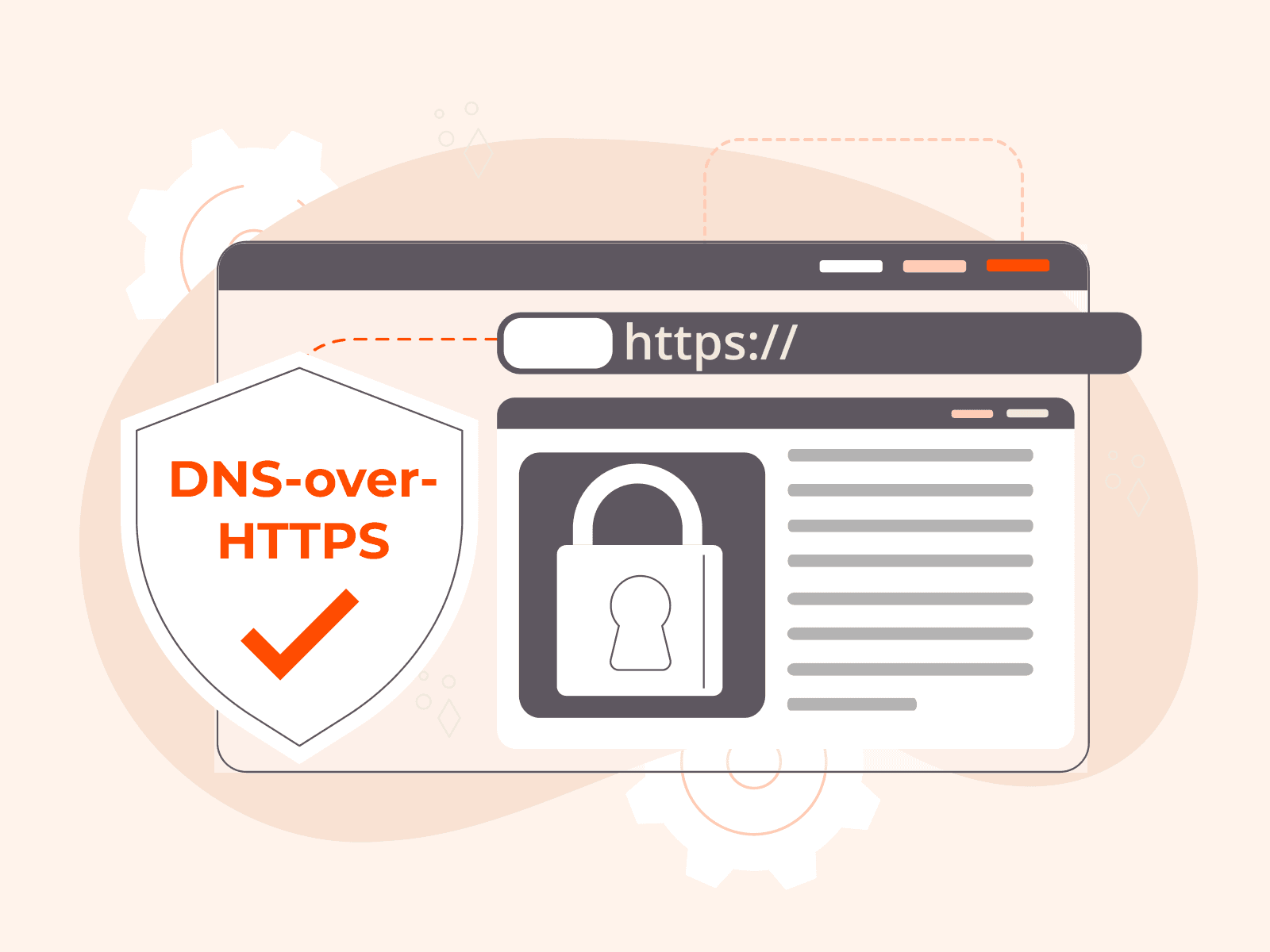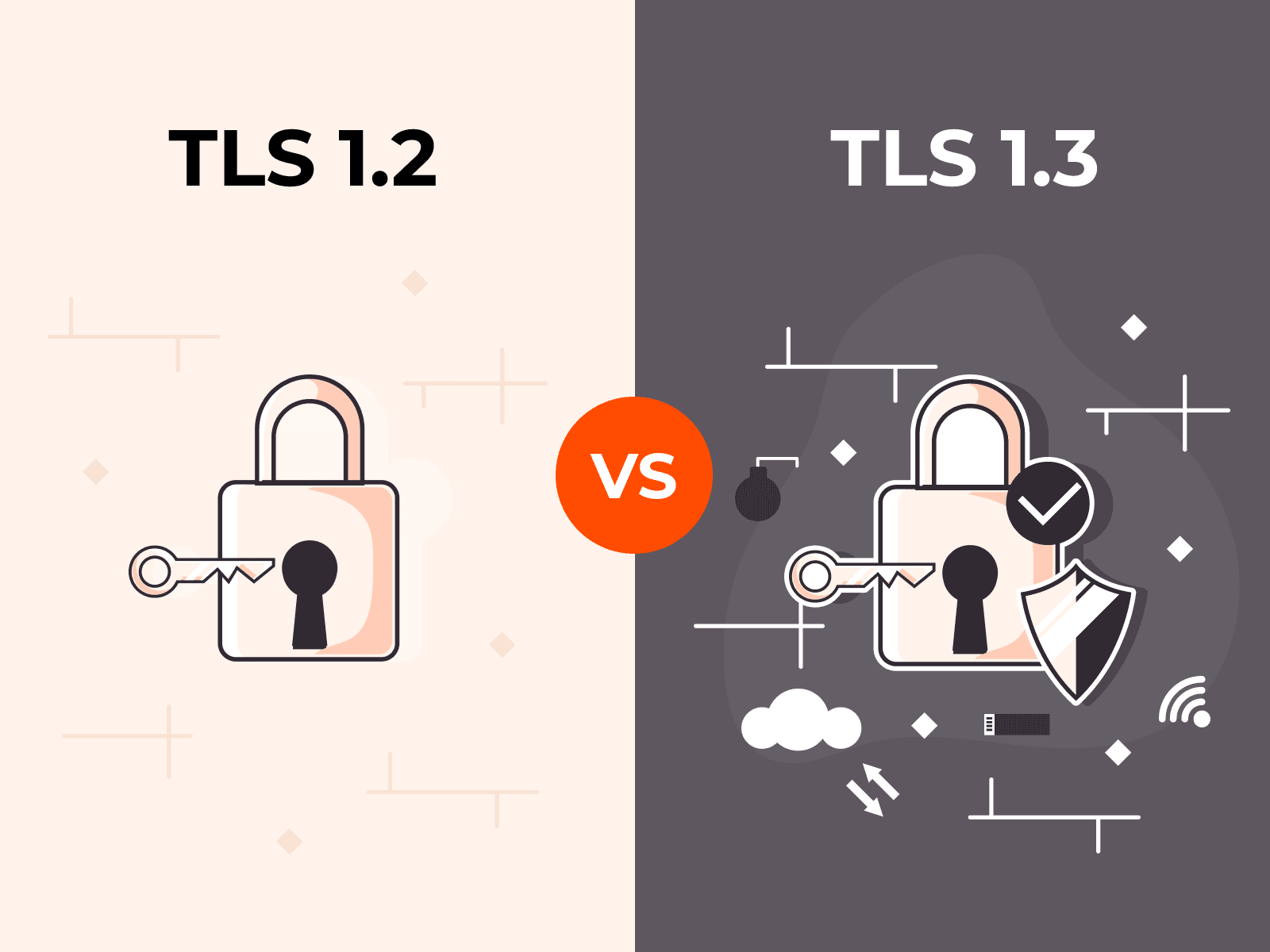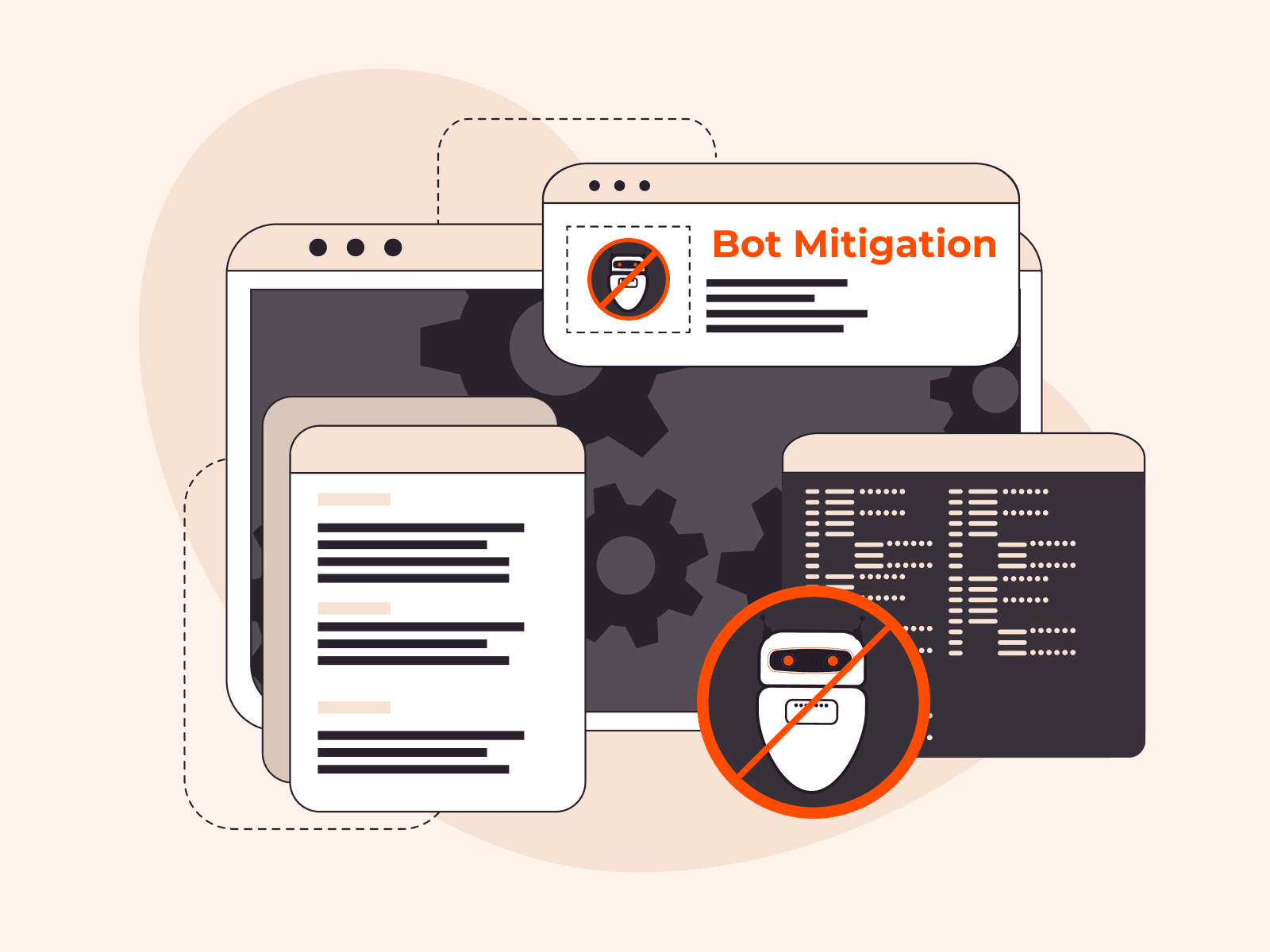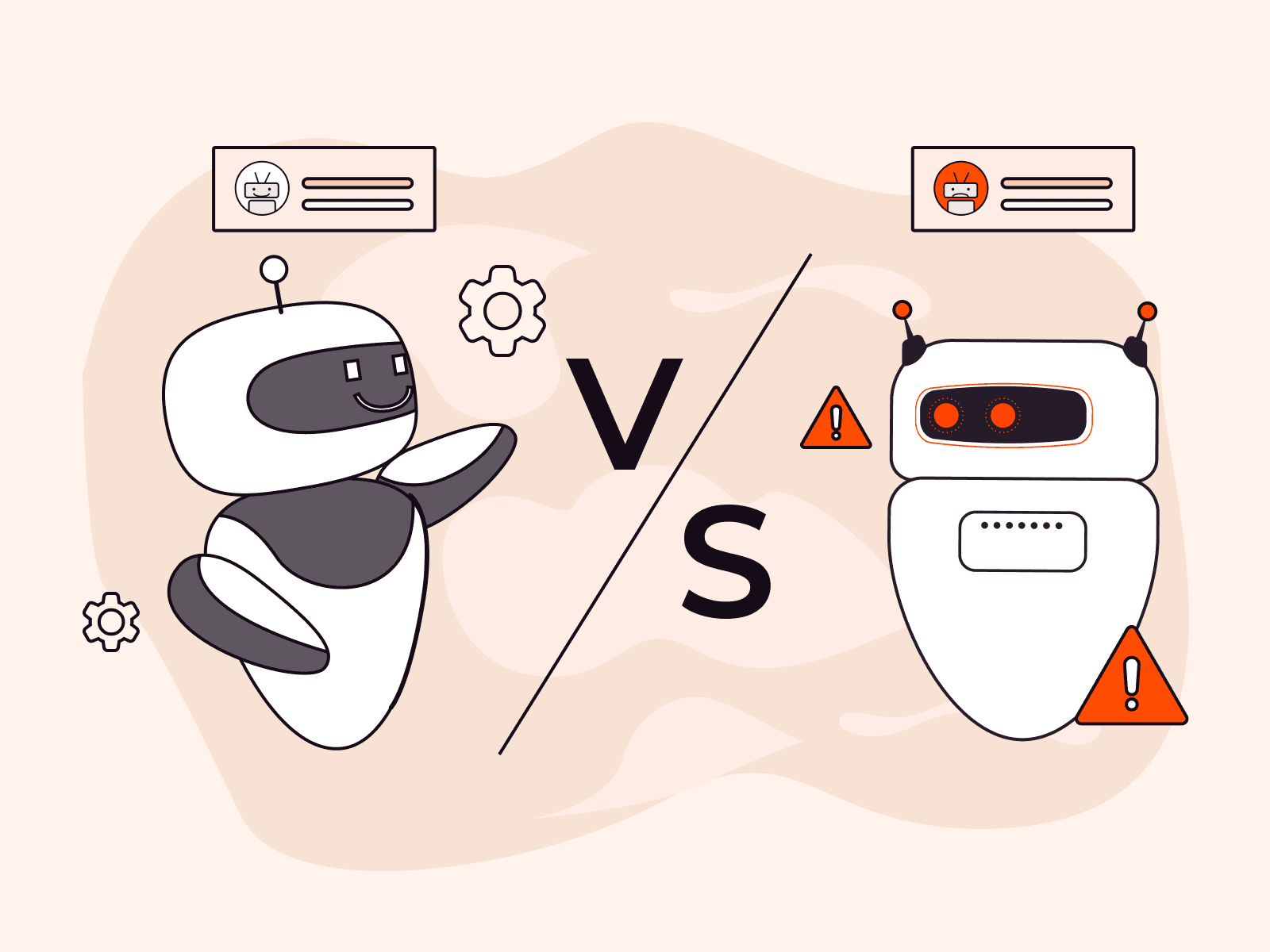What Is a Man-in-the-Middle (MITM) Attack? | How to Prevent a MITM Attack
- By Gcore
- June 6, 2023
- 9 min read

A Man-in-the-Middle (MITM) attack is a form of cyber attack which threatens data and information security. It occurs when an unauthorized person—a cybercriminal—positions themselves as a conduit between two parties to monitor interactions, steal sensitive information, and manipulate transactions. For example, they can steal trade secrets, compromise financial records, or embed malware on the company’s servers. In this article, we will explain everything you need to know about MITM attacks and outline practical prevention measures that you can take.
What Is a Man-in-the-Middle (MITM) Attack?
A Man-in-the-Middle attack occurs when a cybercriminal intercepts the network between two parties to eavesdrop, spy, or steal sensitive information. The attacker can also manipulate the personality of either party by injecting new data into the communication.

MITM attacks exploit vulnerabilities like weak encryption, insecure public Wi-Fi networks, and unverified website certificates. Let’s find out how.
How Do MITM Attacks Happen?
Usually, MITM attacks comprise two steps. The details depend on the attacker’s objectives and the nature of the communication between the two parties, but there are some broad activities that characterize MITM attacks.
Step 1: Interception
During interception, an attacker first gathers information about the target network or the communication channels through reconnaissance. Reconnaissance tools—such as network scanners—discover potential entry points and vulnerabilities.
Next, the attacker uses methods such as spoofing (see the next section for more methods) to intercept the communication between the two parties and hijack the traffic before it reaches its destination. Attackers then capture and read the content of the exchanged messages.
Step 2: Decryption
If the intercepted network is encrypted, the attacker uses decryption methods such as RSA to capture the messages in the original plaintext. Decryption is only possible if the encryption techniques employed by both parties in the network are weak. After decryption, the attacker modifies and manipulates the content, often by injecting malware or requesting sensitive information in the guise of a legitimate party.
After achieving their objectives, the attacker covers their tracks by returning the communication channel to the original state.
What Methods Do MITM Attacks Use?
During the interception phase, man in the middle attackers use various methods to intercept the communication between the two parties and hijack the traffic before it reaches its destination. Let’s look at the seven most common methods attackers employ to execute MITM attacks.
Phishing
In phishing, attackers use malicious links, emails, or websites to trick either party into revealing sensitive information, such as login credentials or credit card information. Attackers often create fake login pages that appear genuine and ask either party to input credentials that are captured immediately.
Example: An attacker disguises themselves as a bank and sends a professionally written email requesting that a user logs into the bank’s website to verify certain details. The user clicks the link in the email and inputs their banking credentials, but the page never loads. The user considers it a network glitch, but the attacker has successfully captured the credentials and used them on the bank’s original website.
Session Hijacking
Attackers may intercept any of the two party’s login sessions into the network by sniffing valid session cookies or tokens.
Example: Cookies and tokens are confidential details sent by the networks to a user’s browser during login. In this method, the attacker sniffs the token and uses it as a ticket into the network even after the original user has gained access.
Spoofing
Spoofing occurs when attackers disguise themselves as another person or source of information. Spoofing can be executed through four major channels: ARP, IP, DNS, and HTTPS.
| ARP spoofing | Address Resolution Protocol (ARP) spoofing is a method where an attacker spoofs network ARP tables to redirect traffic to their device instead of the intended recipient. The attacker forges fake ARP requests/replies to targets. The victims update their ARP cache with the attacker’s MAC address instead of the genuine target’s. This causes the traffic between the targets to split, with one part going from the first party to the attacker, and the other going from the second party to the attacker. |
| IP spoofing | Here, the attacker manipulates the Internet Protocol (IP) address of the systems in a network by altering the packet headers of the applications in the network. Once either party initializes the application, all information is routed to the attacker. |
| DNS spoofing | With Domain Name System (DNS) spoofing, attackers redirect the traffic to a fake website or a phishing page. This is achieved by modifying the victim’s DNS cache so that the domain name resolves to a fake IP address controlled by the attacker, leading the victim to the attacker’s fake website. |
| HTTPS spoofing | HyperText Transfer Protocol Secure (HTTPS) is the foundation of communication on the web. In HTTPS spoofing, an attacker sends a certificate to their target’s browser after the victim initially requests to secure the site. The phony certificate holds a digital thumbprint of the compromised browser or application. The browser then verifies the thumbprint using a list of recognized trusted sites. When the victim visits the website or transmits data via the browser, the attacker intercepts the desired information before it reaches its intended destination. |
Wi-Fi Eavesdropping
Attackers can carry out MITM attacks by intercepting or forging the credentials of genuine Wi-Fi access points, luring unknowing users to connect to their fake Wi-Fi hotspots. Threat actors can intercept website connections and acquire unencrypted sensitive information through such an attack.
Example: The attacker places a Wi-Fi hotspot near McDonald’s. The point is called “McDonald’s” and does not have a password. Thinking it’s the restaurant’s Wi-Fi, users connect to it and access the internet through it. The attacker gains access to all sent and received data.
SSL Hijacking
Secure Sockets Layers (SSL) encrypt the connection between a browser and a web server. In Secure Sockets Layers (SSL) hijacking, the attacker intercepts the SSL/TLS traffic between the sender and receiver’s device and impersonates a server. The attacker forces a downgraded SSL connection, steals the SSL certificate and key, and mimics the genuine website, making the victim believe they are interacting with a genuine server.
The attacker can then decrypt the intercepted SSL/TLS traffic, giving them full access to the data exchanged between the user and the server. This may include sensitive information like login credentials, credit card details, or personal information, which they can misuse for malicious purposes.
SSL BEAST
SSL Browser Exploit Against SSL/TLS (BEAST) targets a specific Transport Layer Security (TLS) vulnerability in SSL. The attacker infects their target’s computer with malicious JavaScript to seize encrypted cookies sent by a web application. The application’s cipher block chaining (CBC) is then compromised so the attacker can decrypt its cookies and authentication tokens. Then, the attacker can impersonate the victim and gain access to their web application accounts. As a result, they can cause harm to the victim by stealing sensitive information or performing fraudulent transactions.
SSL Stripping
This man in the middle method intercepts the TLS authentication sent from an application to a user and downgrades an HTTPS connection to HTTP. The attacker sends the user an unencrypted version of the application’s site. Even when the victim maintains a secure session within the application, the session is visible to the hacker, meaning that sensitive information like passwords or financial data are exposed.
Example: example.com, an HTTPS-enabled website, typically sends a secure TLS authentication to each browser. But in this instance, the attacker intercepts this TLS authentication sent by example.com to the user’s browser, removes the extra layer of security that HTTPS enables, and routes the unsecured version to the user’s browser. This exposes the user to exploitation and theft.
Have MITM Attacks Happened Before? What Are Some Examples of MITM Attacks?
Yes, there have been several notable MITM attacks. Let’s review some of the most potent and infamous instances:
| Firm | Impact |
| DarkHotel (2017) | DarkHotel is a group specializing in hacking hotel guests. In 2017, they used MITM attacks to steal sensitive data from business travelers staying in luxury hotels. |
| The Superfish scandal (2015) | This scandal occurred in 2015 when Lenovo laptops were shipped with adware that exposed personal information—such as login credentials—to phishing attacks using MITM methods. |
| Hacking Team (2015) | Italian cybersecurity company Hacking Team sells surveillance and intrusion software to governments and law enforcement agencies worldwide. In 2015, they experienced a data breach whereby attackers utilized a MITM attack to grab the two-factor authentication code of an employee, which gave them access to the organization’s servers and sensitive company information. |
| The Jackpotting attack (2014) | In this 2014 attack, cybercriminals used insecure Wi-Fi connections to conduct MITM attacks on ATMs. They targeted the network infrastructures of ATMs and infected them with malware, allowing them to hijack the machines, intercept card data and dispense cash illegally. This attack resulted in the theft of millions of dollars from banks. |
| Target Corporation (2013) | In 2013, Target Corporation experienced a massive data breach that affected over 110 million customers. Attackers used a variant of a MITM attack known as RAM scraping to steal sensitive information, such as credit card data, during transactions at point-of-sale (POS) systems. |
| The 2015 GBP 333,000 attack | In 2015, Paul and Ann Lupton’s email exchange with their real estate solicitor was intercepted by cybercriminals. The cybercriminals requested the Luptons’ bank accounts for the transfer of funds from a home sale. The solicitor sent the funds worth just over GBP 330,000 to the criminals’ accounts. It took a few days before either party discovered that there had been a breach. |
Can MITM attacks be prevented?
Yes, MITM can be prevented in many instances. Facebook and Apple offer case studies of organizations that successfully mitigated MITM attacks, and the preventative techniques they used afterwards to strengthen protection against MITM attacks.
The fact that tech giants suffer from MITM attacks shows that MITM attacks can happen to anyone—and the techniques they used can be applied by businesses of all types and sizes.
In 2011, researchers uncovered a vulnerability in Facebook’s SSL/TLS implementation, which could have allowed attackers to conduct a MITM attack on Facebook users. Facebook implemented “forward secrecy” technology to prevent such attacks for all SSL/TLS connections. This means that if an attacker successfully intercepts the SSL/TLS session, previous user interactions can not be decrypted.
As a result of discovering this weakness, Facebook additionally implemented a domain name system security extension (DNSSEC,) which prevents DNS tampering and spoofing. They also employed Secure Hash Algorithm 2 (SHA-256) to secure their SSL/TLS certificates.
Apple
In 2014, Apple faced potential man in the middle attacks on iOS devices due to a critical security flaw within the app’s API. To prevent such attacks, Apple released patches for its iOS devices. The patches introduced features such as Application Transport Security (ATS,) which ensures that an app connected to the internet or a local network must use secure communication protocols (HTTPS) to protect communication between a server and an app.
Apple devices also feature Wi-Fi Assist to secure Wi-Fi network communications and prevent MITM attacks. This feature automatically switches off connection to unsecured networks and switches to cellular networks when Wi-Fi reliability is poor.
7 Best Practices to Prevent MITM Attacks
If tech royalty can get tangled up in a mess of MITM attacks, then every single organization must use preventive best practices to ensure they steer clear of this danger. These best practices aren’t foolproof, but they’ll give you a serious head start to deter attacks before they start and make a successful attack less likely. Here are eight best practices you can immediately implement.
1. Encrypt your Network and Channels
Encryption involves encoding data into a code that only the sender and the receiver can access. In this age of remote work, it is important to use encrypted Wi-Fi networks and ensure that your online transactions are HTTPS-enabled. Encrypting both the data and the communication channel offers superior protection. You can encrypt data both in transit (i.e., data transferred from one device to another) or at rest (i.e., data stored on devices.) Both forms of encryption are possible using SSL and TLS.
Weak encryptions can still be decrypted by attackers, as mentioned earlier. This makes strong encryption all the more important for avoiding and preventing MITM attacks.
2. Use Strong Authentication Protocols
Use strong authentication protocols such as Multi-factor authentication (MFA) that are difficult to bypass and require the provision of two or more proofs of authenticity. If hackers intercept credentials such as usernames and passwords, they cannot gain access without the second authentication factor, which may comprise biometric data, smart cards, or hardware tokens.
Token-based authentication is another MFA solution you should consider. By utilizing a unique device that generates a temporary passcode, both parties in the network are granted access to sensitive data and network systems.
3. Use VPNs
Virtual private networks (VPNs) provide a secure tunnel between a user’s device and the internet, making it difficult for attackers to intercept data. By encrypting the data in transit, attackers cannot read the contents of the data even if they intercept it.
4. Install Intrusion Detection/Prevention Systems (IDS/IPS)
IDS and IPS monitor network traffic and alert administrators when there is abnormal activity, such as attempts to hijack your network’s traffic. Intrusion prevention systems can also prevent attacks by blocking malicious traffic or applying mitigation measures.
5. Undertake Regular Network Security Audits
Regular network security audits can help identify potential MITM vulnerabilities early and assist organizations in taking proactive measures to address them. SSL/TLS certificates protect emails in transit, and PGP/GPG encryption protects them at rest.
Additionally, setting segmentation policies—such as endpoint micro segmentation—is important, because it moves users into a protected environment, isolating them from the local network. Some segmentation policies operate as a bidirectional firewall to prevent data leakage and maintain secure traffic within the network gateway.
6. Update and Patch Software
Separate sensitive data from other data located in hybrid storage. Implement efficient patch management by regularly updating the software and antivirus security systems, promptly applying software patches on all devices, and scheduling auditing and monitoring to alert you about normal and unusual activities within your network. Efficient patch management also entails revisiting and upgrading your firewalls as your data volumes grow.
7. Offer Employees Security Awareness and Training
One of the most common methods of man in the middle attacks is phishing. With this method, attackers trick individual employees into divulging login credentials or installing malware on their devices. According to IBM’s 2022 Cost of Data Breach Report, phishing was the second most common cause of a breach, accounting for 16% of cases. It was also the costliest, averaging USD $4.91 million in breach costs.
Employees must therefore be trained to avoid clicking on suspicious links and emails. Organizations should also warn their staff from using public Wi-Fi networks for their job as part of security training.
8. Use a Third-Party Protection Solution
Your in-house cybersecurity tools may also be prone to MITM attacks orchestrated through social engineering methods like phishing. Adding an extra layer of protection by employing third-party services like Gcore boosts protection from MITM attacks.
However, not all solutions out there are efficient. Search for reviews and feedback from other customers; make sure whatever solution you employ has been in business for a while and uses next-generation technology like ML-enabled data encryption. Finally, ensure that the solution has a responsive customer support team and a service-level agreement (SLA) that defines the quality of service you can expect.
Gcore Tools Help Prevent Man-in-the-Middle (MITM) Attacks
Gcore is a trusted security solutions provider with products that can help prevent all methods employed in Man-in-the Middle (MITM) attacks. We offer DDoS mitigation, DNS hosting, and web application security for business.
Conclusion
A Man-in-the-Middle (MITM) attack is a sophisticated and common cyber-attack that can adversely impact the security of individuals and organizations. Preventing MITM attacks requires an understanding of the attack process and implementation of comprehensive security measures. A reliable third-party, like Gcore, can provide robust protection against MITM attacks. Get a free consultation with our security expert to learn more.
Related articles
Subscribe to our newsletter
Get the latest industry trends, exclusive insights, and Gcore updates delivered straight to your inbox.





